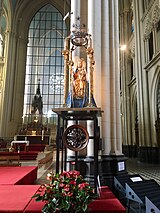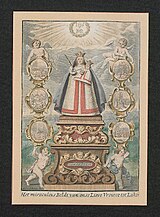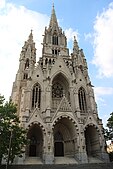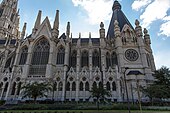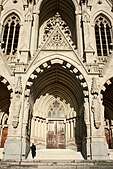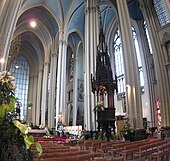Church of Our Lady of Laeken
| Church of Our Lady of Laeken | ||
|---|---|---|
| ||
| Administration | ||
| Archdiocese | ||
| Clergy | ||
| Archbishop | Luc Terlinden (Primate of Belgium) | |
The Church of Our Lady of Laeken (
The Royal Crypt underneath the shrine is the main resting place for the members of the Belgian royal family, with some notable artisans also interred at the nearby cemetery.
History
Inception and construction
An older painting of Our Lady of Laeken, dating back to 1637, is preserved at the site. A devotional booklet dedicated to this Marian title was published with imprimatur by the Catholic deacon in Brussels, pastor Hubert Cœkelberghs, on 17 July 1874.

The architect
The first stone was laid by Leopold I in 1854. In 1865, Poelaert, absorbed by the Law Courts project since 1862, claimed health problems and gave up the management of the works.[4] Several architects succeeded him: Auguste Payen, Antoine Trappeniers, Louis de Curte and Alphonse Groothaert.[3]

The church is monumental, and although consecrated in 1872, apart from maintenance and consolidation works, its completion was resumed only after a lengthy interruption.[2][5] It was King Leopold II who, concerned about the embellishment of the place, in 1896, relaunched the project still compromised by the lack of funds. In 1902, as the building continued to deteriorate, a Munich architect, Baron Heinrich von Schmidt, was commissioned to carry out a general examination of its condition.[6] In 1907, the Government approved his plan to complete the main facade, the monumental porches and the central tower. This work was carried out from 1909 to 1911.[7]
Renovation
In 2003, a restoration project began on the front facade and the three towers (2003–2006), the roofs (2007–2009) and the side facades (2010–2012). During this restoration, the architectural office MA² - Metzger et Associés Architecture, specialising in historic buildings, advised against any carving, at the risk of causing irreversible damage to the ageing stones. All that was done was to treat the exterior of the church against acid rain.[3][8][9]
Marian cult and veneration
This section needs additional citations for verification. (November 2023) |
The Marian image is a 13th-century wooden carved statue in the
The ornamental crown with canopy was added in 1934, and is carried by the four Biblical women:
Accordingly, this venerated Marian image became the source for the image of Our Lady of China, crowned by a decree of Pope Francis on 19 February 2021.
Royal Crypt
The Royal Crypt underneath the church holds the tombs of the Belgian royal family, including those of all the Kings of the Belgians and their wives.[2][10] These tombs include:
- Leopold I of Belgium[5]
- Louise of Orléans
- Prince Baudouin of Belgium
- Prince Leopold, Duke of Brabant
- Marie Henriette of Austria
- Leopold II of Belgium[5]
- Princess Marie of Hohenzollern-Sigmaringen
- Charlotte of Belgium,[5] later known as Carlota of Mexico, empress consort of Emperor Maximilian I of Mexico
- Albert I of Belgium
- Astrid of Sweden[5]
- Elisabeth of Bavaria
- Prince Charles, Count of Flanders
- Leopold III of Belgium
- Baudouin of Belgium
- Lilian, Princess of Réthy
- Prince Alexandre of Belgium
- Fabiola de Mora y Aragon
The adjacent
Gallery
-
Frontal view
-
Lateral view
-
Main portal
-
Interior
See also
- List of churches in Brussels
- Roman Catholicism in Belgium
- History of Brussels
- Culture of Belgium
- Belgium in the long nineteenth century
References
Citations
- ^ Cosyn 1904, p. 41.
- ^ a b c State 2004, p. 218.
- ^ a b c "Église Notre-Dame de Laeken – Inventaire du patrimoine architectural". monument.heritage.brussels (in French). Retrieved 7 March 2023.
- ^ Spapens & Gombert 2006, p. 58.
- ^ a b c d e "Church of Our Lady of Laeken". Laeken.Brussels. Retrieved 12 December 2022.
- ^ Spapens & Gombert 2006, p. 71.
- ^ Spapens & Gombert 2006, p. 130.
- ^ "Restauration de l'Église Notre-Dame de Laeken". Beliris (in French). Retrieved 7 March 2023.
- ^ "Église Notre-Dame de Laeken". MA² - Metzger et Associés Architecture (in French). Retrieved 7 March 2023.
- ^ "Royal Crypt in Laeken". The Belgian Monarchy. Retrieved 20 January 2024.
- ^ State 2004, p. 63.
Bibliography
- Cosyn, Arthur (1904). Laeken ancien et moderne (in French). Brussels: Imprimerie scientifique Charles Bulens.
- Spapens, Christian; Gombert, Charles (2006). L'église Notre-Dame de Laeken, un mémorial inachevé (in French). Brussels: Centre d'information, de Documentation et d'Etude du Patrimoine.
- State, Paul F. (2004). Historical dictionary of Brussels. Historical dictionaries of cities of the world. Vol. 14. Lanham, MD: Scarecrow Press. ISBN 978-0-8108-5075-0.
External links
 Media related to Church of Our Lady of Laeken at Wikimedia Commons
Media related to Church of Our Lady of Laeken at Wikimedia Commons

